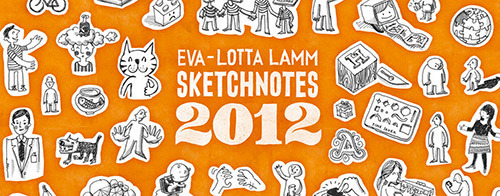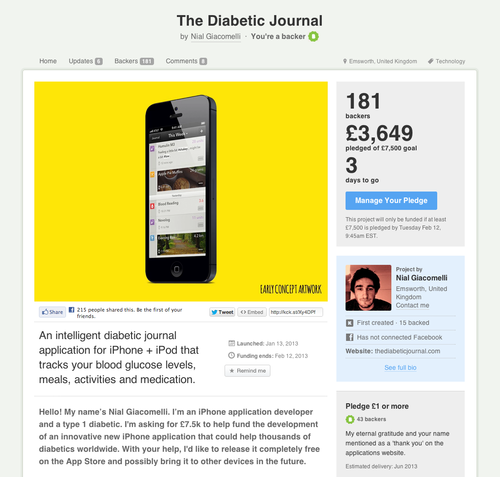Cameron Moll's Blog, page 6
March 4, 2013
Eva-Lotta Lamm’s ‘Sketchnotes 2012’
I wish I could sketch like Eva-Lotta Lamm. I really do. Her sketches are pretty incredible.
Her new book, Sketchnotes 2012, is now available in print and PDF. “Visual notes of countless talks by inspiring speakers” from around the globe, as Eva-Lotta describes it. You can find the book on Amazon, too.
And somewhere amongst its pages you’ll find her notes from my talk in Düsseldorf last Fall.
Coffee table book? Pfft, no. This is a tome of inspiration. And in my case, envy.
March 1, 2013
“All we did was make something beautiful.”
A behind-the-scenes creation of the “Born & Raised” artwork for John Mayer’s album, from the hands of traditional sign-writer David A. Smith.
John Mayer’s own words (01:55), describing the artwork:
In this world we live in where everybody is trying to figure out the next strategy for PR, all we did was make something beautiful.
Who knew John Mayer had such a penchant for great design?
The font David created for the album, Mayer Font, is also available for purchase.
/via Quipsologies
February 25, 2013
“Play by your own rules.”
Josh Williams, recounting the history of founding Gowalla and the inevitable tussle with Foursquare:
A week before launch I came across some interview with Dennis Crowley where he described a new project that he and Naveen Selvadurai had been working on. It was called foursquare.
A week later Gowalla and foursquare would launch on the same day.
Eventually, an unassuming entrant would join the story:
While we were busy playing tug-of-war over check-ins, someone else found a path to the goal with less friction.
That “someone else” was, of course, Instagram.
About a year after the launch of Instagram, Gowalla’s service would shut down and several of us would join Facebook. Others would move on to new endeavors of their own. Ironically a couple from the team would join Instagram.
This is really terrific writing from Josh, whom I’ve been lucky to count as friend for a number of years. The concluding advice is clearly coming from the mind of a very seasoned entrepreneur:
Listen to your users more than the press. Don’t get sucked into the gravity hole between you and your competition. Ruthlessly run your own path, not someone else’s.
Set aside time to read the entire piece. Oh, and more writing please, Josh.
February 14, 2013
Is sketching dead?
No, of course it isn’t.
But that’s not as attractive as “Is [popular software] dead?” and doesn’t garner the same debate (and retweeting). Nonetheless, the question is the all the same: “Is [your method for visualizing ideas] dead?”
I’m one of those chumps who uses [popular software] as a means of expressing what’s in my mind, exploring options that haven’t yet crossed my mind, and articulating ideas to others. That sounds a heckuvalot like sketching, doesn’t it?
Understandably, the higher fidelity offered by [popular software] vs. sketching has the potential to mislead clients and inhibit idea-to-code workflow. But what is to be said of those who work in small in-house teams with a shared understanding of the web? Or of those who find the tool to be masterful for architecting and refining ideas, despite its limitations?
It’s not uncommon for me to share a static image—not the original document file, but simply an image—with Adam, who takes my design ideas for Authentic Jobs and brings them to life as code. That static image is no more inhibiting nor less articulate than a sketch. Nor any less than a screenshot (or actual code) of an adjustment I make to live code using WebKit’s Inspector.
We deserve better tools, yes. We’re obligated to try new methods. And we can debate the advantages and shortcomings of each tool and each method, to move us forward as an industry. But let’s do so in way that recognizes the personal preferences of individuals, and that acknowledges the fact that many of these tools and methods have produced, and continue to produce, successful work.
Coincidentally, this article by Javier Ghaemi is a notable example of moving us forward while recognizing the mastery of the tool debated.
February 12, 2013
Yours vs. Mine, a UI Conundrum
Dustin Curtis, adding his voice to a dilemma that I’ve had to wrestle with almost since day one of my career:
A question that inevitably comes up very early in the process of designing a new app is this: should the interface refer to the user as “your” or “my” when talking about the user’s stuff, as in “my profile” or “your settings”? For a long time, this question ate at my soul. Which is right?
Dustin sides with the “yours” camp, as have I for quite some time:
After thinking about this stuff for a very long time, I’ve settled pretty firmly in the camp of thinking that interfaces should mimic social creatures, that they should have personalities, and that I should be communicating with the interface rather than the interface being an extension of myself.
Others, notably Twitter for example, side with “mine”:

However, there’s a third option that deserves attention. No, not third person, though that’d make for an interesting user experience (“Her Profile”). It’s simply making the interface clear enough that pronouns and possessive adjectives aren’t needed. “Profile”, “Documents”, and the like.
In today’s world of following, favoriting, and friending, it’s increasingly difficult to distinguish between what’s yours (mine?) and what’s theirs (yours?). Understandably, labels are still needed, despite our best efforts to present the UI with clarity.
Hence, I’ll continue to side with “yours” as long as it remains necessary. There’s nothing worse than a FAQ page that says, “Please visit your ‘My English Lit’ page to learn more about pronouns and possessive adjectives.”
February 11, 2013
“Alive, but not fun to spend time with.”
Using a [minimum] viable product is like visiting someone in an intensive care unit. They’re alive, but not fun to spend time with. As a result, I see more and more companies who focus on MVP produce products that fail to achieve their goals.
Instead, Ian suggests shifting development focus to creating a “Minimum Delightful Product”:
When a product is delightful it just makes sense. It works the way you’d expect and the experience is highly satisfying. Delightful products are adopted faster, get better word of mouth, and create higher satisfaction.
Those are claims that warrant data to back them up. But I can say from personal experience—and I bet you can too—that I have signed up for many websites and apps, only to leave some of them within 5 minutes after registration, never to return. They functioned, indeed. But they failed to delight and didn’t fill a void.
I side with something said at SXSW 2012 by @TravisBogard:
It’s not about being first, it’s about being first to get it right.
Boom.
/via @nicepaul
February 8, 2013
A Diabetic’s Journal
It’s strangely coincidental that earlier today Mark Boulton wrote about his daughter’s school being slated for closure, including a personal note from his daughter’s hand. For earlier this week I had planned to pen something similar, only a stone’s throw away from the tone of his.
One of my sons is a Type 1 diabetic. He was diagnosed during a cross-country trip three years ago. Unlike Type 2 which can be managed through better health, currently there is no cure for Type 1. Once diagnosed, you cope with it for life—daily shots and all.
Often we’re reminded he isn’t alone. There are many others around the globe that live happy, productive lives as Type 1 diabetics. Some names are even recognizable: Jay Cutler, Nick Jonas, Victor Garber, and many more. These, and the many other unknown-but-undeniably-important names, give him, give us, hope.
One of these names that have given us a substantial amount of hope recently is Nial Giacomelli. An iPhone developer based in the UK, Nial is also a Type 1 diabetic. His Kickstarter project, The Diabetic Journal, hopes to fund the last leg of development by raising £7,500 for reporting tools and visual design help. The app will be released in the App Store for free, if funded.
If your financial circumstances allow, please back Nial’s project by pledging £1 or more. My son and so many more like him will be in indebted to you for helping make their lives a little easier to manage.
All of this brings me to Mark’s daughter and her heartfelt letter. While we were in the hospital adjusting to life with diabetes, my son wrote an entry in his journal. He was six at the time. I photographed the entry while at the hospital:

It reads:
I love the Hospital. It’s fun. I like the foods in the Hospital. I love when Mom and Dad help. I like when people help me get better. The end.
Although the week we spent in the hospital was one of the worst weeks of our family’s life, you wouldn’t know it from his letter. “I like when people help me get better.” Like Nial. Like you.
The end.
February 7, 2013
Using objective data to justify responsive websites
We took a popular ecommerce store (O’Neill Clothing) that we’d recently redesigned and monitored conversions, transactions and revenue for three weeks. Then we quietly deployed the responsive conditions to the already live site and monitored for another three weeks….
iPhone transactions more than doubled. Android transactions more than tripled. All from relatively quick optimization.
In the article, they lay out some pretty impressive increases in conversions, transactions, and revenue as responsive features were introduced to the site.
Coincidentally, Electric Pulp is hiring a PHP Developer and Front-End Developer. Candidates local to South Dakota preferred, but telecommute and relocation are options, too.
/via @RWD
February 5, 2013
"Design is a business activity."
Erika Hall, guest author in A List Apart’s “What We Learned in 2012”:
Changing the design of an interactive system changes the organization behind it…. Organizations are just groups of people with goals, rules, and customs. Designers are just people with certain skills. But because of insecurity on both sides, differences trigger defense mechanisms. We resort to jargon. All the hoo-ha around “design thinking” is just a distraction. Design is a business activity. It goes well when designers and businesses work together to solve a real problem with good information and clear goals. The hard part is confronting all the specific mundane things that interfere.
Plenty of other savvy observations in ALA’s round-up from various authors, including predictions for the coming year.
January 24, 2013
“The problem of sitting comfortably was solved already.”
Yaron Schoen adding (subtly) his voice to the “flat design”, “to PSD or not to”, and skeuomorphism banter making the rounds of late:
Clearly without function, form is pointless. But a beautiful and timeless product has both an elegant solution and an elegant aesthetic, it rarely ever is one or the other. For example, the problem of sitting comfortably was solved already, what makes the Eames chair iconic is its timeless beauty and its comfortableness….
There are many ways to achieve or interpret beauty, it’s not an absolute science. If it were we’d all be out of a job and life would be pretty boring.
Takeaway: Beauty has, and will always have, a place in making our world better. But we designers should avoid absolutes, even if they seem reasonable. (After all, the skilled designer intentionally breaks rules from time to time, confidently knowing what the rules are.)
Cameron Moll's Blog
- Cameron Moll's profile
- 4 followers





